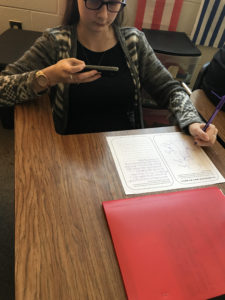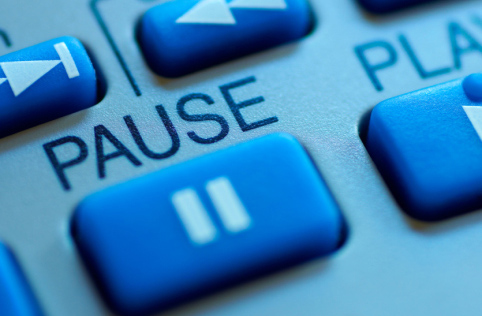Three seconds.
Research has shown that giving students at least three seconds of think time after asking a question increases results in a number of ways. Yet, with time constraints and our students’ waning attention spans, we are continually pressured to crank out questions and answers, call on a variety of students, make sure everyone feels good, bada bing, bada boom, ready to move on.
How long do teachers, on average, wait? ≤ 1.5 seconds. I just asked my husband a series of six questions, easy and personalized ones about his life that he could answer quickly, and only waited 1.5 seconds between before cranking out the next one. He answered the first rapid fire, hesitated on the second, then stopped washing dishes and slow-turned to look at me like, “Really?” as I continued over his hesitation with the next four. Granted, they were back-to-back, but I highly recommend you try it – once he missed a beat, he got frustrated at my impatience, and students do, too. High-flying students see it as a motivating challenge (remember, like us, they aren’t normal) and the rest/majority see it as an impossibility, even if they can respond; they already see that they won’t be given time to have their own unique thought process, so why bother and be embarrassed?
Plus, other content areas have right and wrong answers. Language doesn’t necessarily have that luxury, especially when the teaching is proficiency-based. Because student answers are largely individualized and analytical (even if the response is one-word, how complex was the question/input?), there needs to be some extra think time. There weren’t fifteen minutes to work on a fixed set of problems for the answers to be 3x + 2, 15, 9y, etc. Especially when the input is complex and/or an #authres, the answer is going to need some time to process, and we must allot students said time. Last year, I started timing myself out loud in class before I’d accept any responses, and it was amazing 1. how fast I had been expecting them to respond before, and 2. how much the students benefited. They thought it was corny for me to be so teacher nerdy, but when I stopped counting aloud, I could still see them waiting patiently at least three seconds. (It’s also a good time to give students a heads up that you’re coming to them: “OK, Ansley, coming to you for #1, and Derek, #s 2 and 3, yes? Cool.”)
Should you catch a student off-guard and they need a second to gather themselves, it’s a great time to do a think-aloud: “Take your time, Johnny, and I see that you’re referencing your notes sheet from Tuesday, excellent use of resources – remember, guys, everything is at your fingertips if you’ve been taking care of business, make sure you’re acquainted with the activities we’ve done and the various resources that can help fuel your responses here.” (I just timed myself saying all that out loud the way I would in my classroom, and it took me 17 seconds, which is an additional 17 seconds for Johnny to get his situation together so that his response empowers, not demeans him, plus he got some praise in there too, for persisting and being prepared with the appropriate materials.)
Confession: This did not start coming naturally to me until I made it a habit, about five or six years into teaching, which was probably a maturity issue. Even so, I don’t mind admitting that I must still keep myself in check sometimes. If I say, “Take your time,” I make sure to mean it. Nothing says ‘teacher gotcha’ like a snarky, “Take your time, we’ll wait,” simply because Johnny wasn’t prepared to answer the ambush question. Even if we mean to be genuine, an uncomfortable context and impatient (even if it’s well-meaning) tone can communicate that formative questioning assessments are a trap and that the teacher thinks Johnny is inadequate, neither of which is true (or appropriate).
So, we know that 3+ seconds is helpful cognitively; what else is it good for? Management. It is late April, folks, and teachers (if you’re me) are working to stay afloat, am I right?

Oftentimes, especially with technology in the hands of students (that you may not be familiar with), the Power of Pause can be a moment-altering adjustment. I, for example, react quickly in my classroom. I respond quickly, I have excellent hearing, and my vision (especially for mischief) is pretty darn keen. So, I have to really keep myself in check when it comes to 1. commenting before I know the whole situation, and 2. making sure I know what the heck it is I’m seeing/hearing. And, odds are, at least once a week or so, I find myself totally wrong and I am really glad I kept my mouth shut. Example, you’re in the middle of a warmup that references #authres, namely food products in Colombia. This explanation in the L2 is a pre-cursor to a food commercial MovieTalk and authentic reading. You are SO PUMPED UP — when suddenly, that darn Johnny is at it again, staring at his cell phone while you are outputting blood, sweat, and tears into this input. (OK, exaggeration, but doesn’t it feel that way sometimes?!) Your options here:
1. Stop, make it a huge deal, immediately saying something along the lines of, “Seriously? SERIOUSLY? We’re doing all this, and you’re there on your phone?”
2. Stop talking and look at Johnny, waiting until he sees you, awkwardly.
3. Make a mental note of it and use your proxemics to wander over and double-check what his screen is doing.
If you’re me, and this is last week, you REALLY WANT TO DO #1, like, deep in your soul want to, because HOLY COW, it’s April, and we’re working our butts off for engagement. #2, by the way, isn’t a bad option, but I use it if, and only if, Johnny has been previously re-directed in a kind way. Because everybody is allowed to be a human person – however, if the unwanted behavior is still happening after a warning and a re-direction, then it’s starting to skirt into defiance and/or there’s more at play here. Thankfully, thankfully, thankfully, (did I mention thankfully?) I made a mental note (and kept my face from getting red, as that stuff really ticks me off) and moseyed over near Johnny. Holy cow, am I glad I fought my inner-teacher self and ignored the instinct toward #1 or #2, because it turns out Johnny was looking up the products I was referencing as they came up and following them on social media to read their posts and #authres images. Had I reacted more quickly, I would have looked like a huge jerk to the rest of the class, because Johnny would’ve likely explained himself as I’m talking, “But I was just!” and he’d have been justified in doing so.
WHEW. Dodged that bullet. I would like to say that that’s my usual reaction, but, it’s probably 50/50, and definitely something I work on every day. When we have good relationships with our students, and we’re quick-responders, that can be really tough, because we get comfortable and emotions get involved. Johnny is one of my top students, and it infringed on my value system that he of all people would not be hanging on my every word, but that isn’t fair. He was doing exactly what I would put on paper that the exemplar student does, yet in the moment, I didn’t see it that way. Ah yes, the power of pause.
It’s easy to rush through these last weeks, and class periods, and moments, but I think now, more than ever, is when we need to pause: before soliciting responses, before reacting, and before deciding. All of them are fair game for a decent pause and a deep breath. That pause may stop us from using the L2 too quickly, discounting thought processes, or even hurting a student’s feelings, it’s all context. Regardless, don’t be afraid to pause, asses what’s really going on, how you actually feel about it, and move on in a more mindful, intentional way.


